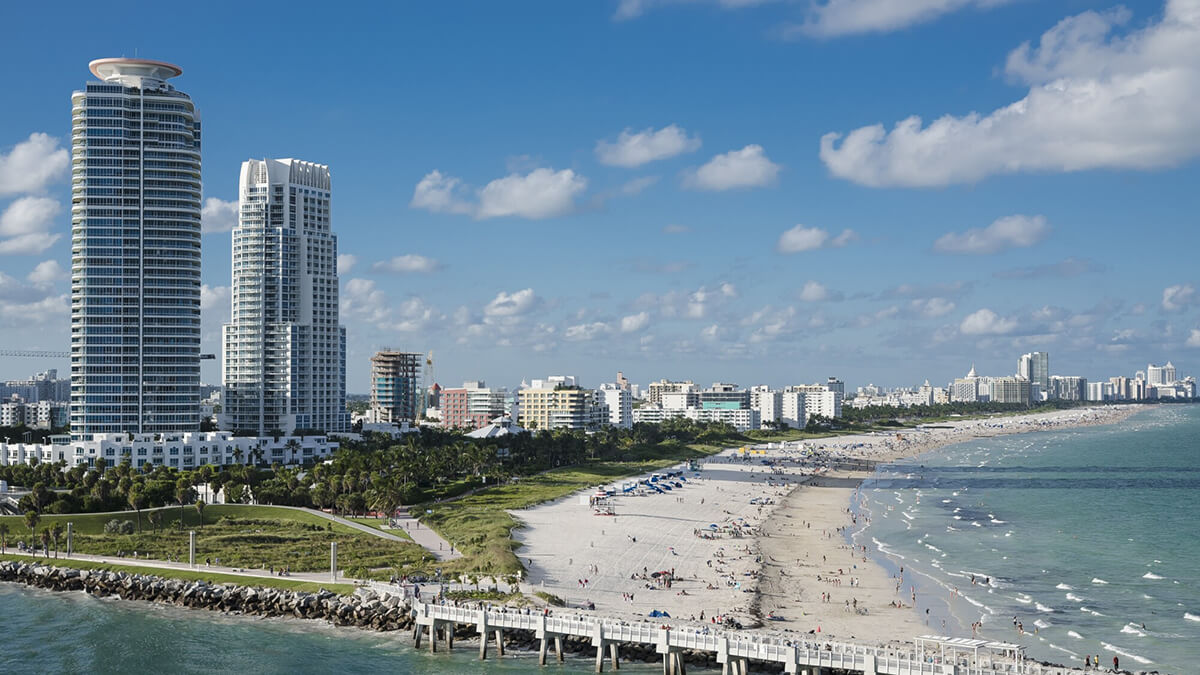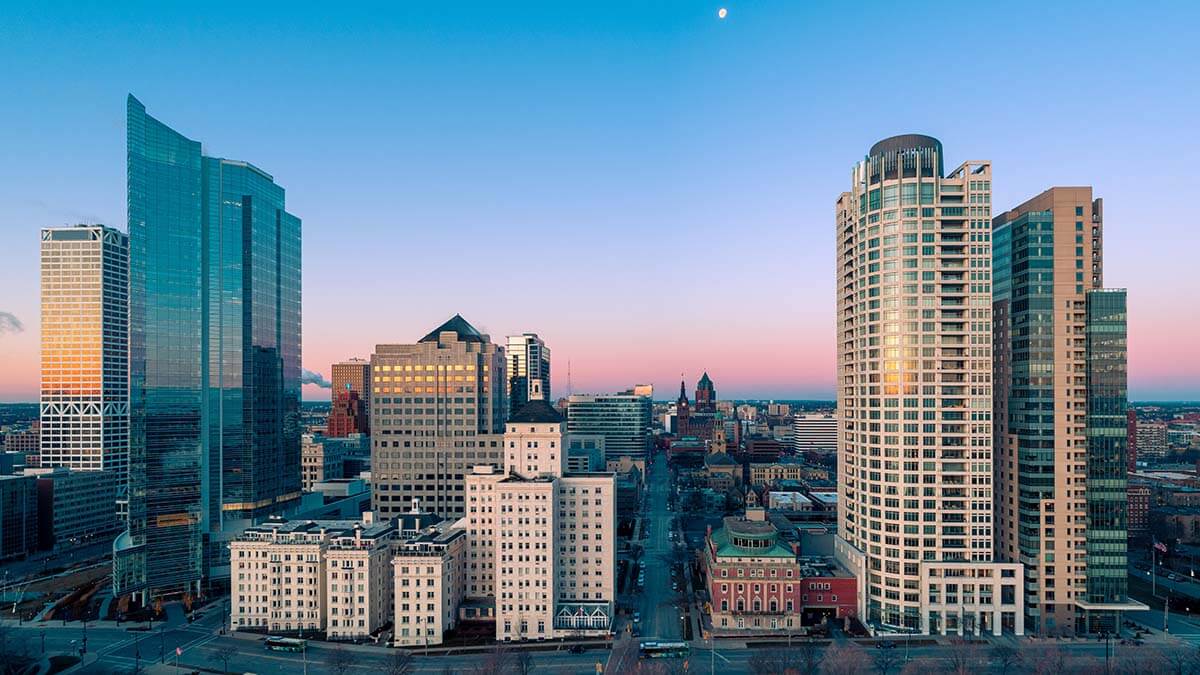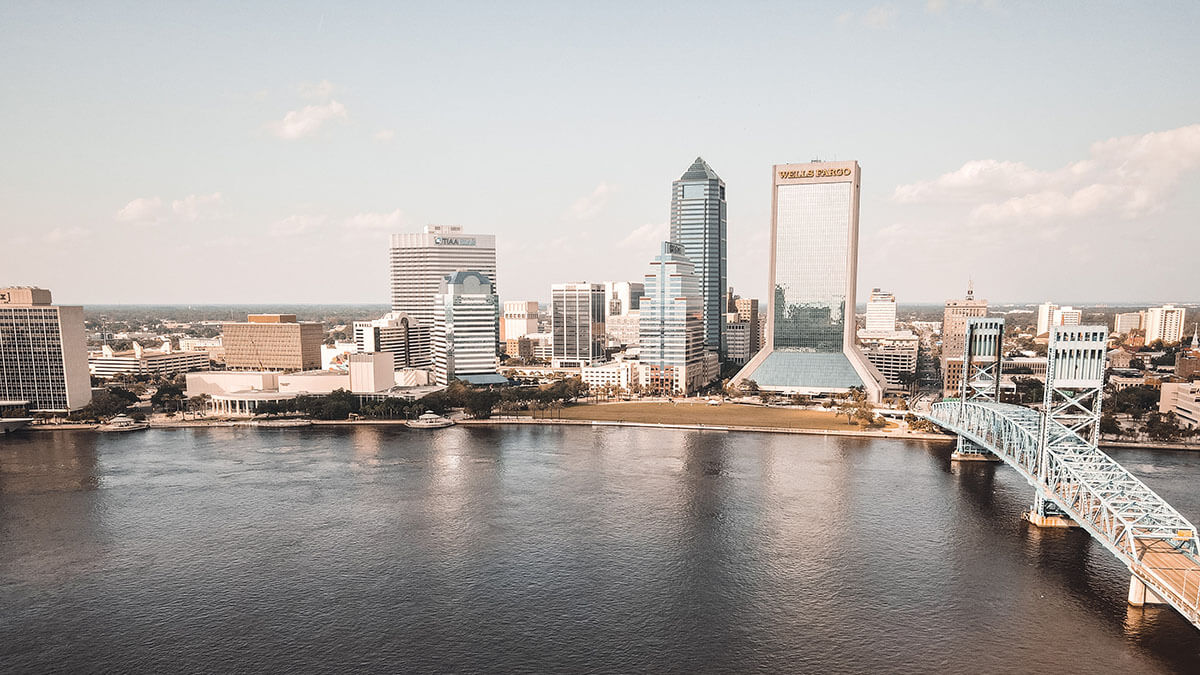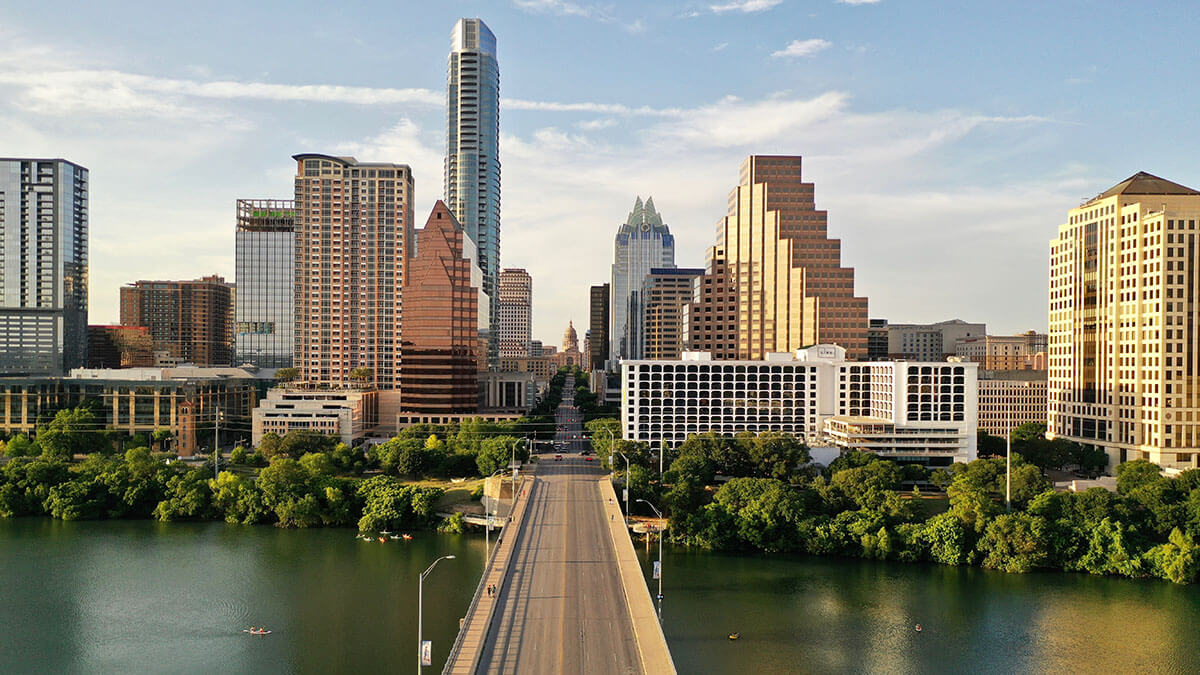Along with the incredible beaches and abundant sunshine, Florida has become a sought out residence due to no income tax and low property taxes, with an average effective property tax rate of 0.91% as of 2024. While real estate prices are higher in cities like Miami, Florida still offers a variety of other areas that have remained affordable.
In this article, we’ll go over eight cities that rank as the most affordable places to live in Florida.
Whether you’re a retiree looking for a peaceful community to settle down or a young professional seeking new career opportunities, iBuyer.com can help you sell your current home quickly so you can begin your move to the Sunshine State.
Cheapest Places in Florida
Compare Cash Offers from Top Home Buyers. Delivered by Your Local iBuyer Certified Specialist.
One Expert, Multiple Offers, No Obligation.
1. Daytona Beach
Originally, Daytona Beach was a citrus and sugar cane plantation—later turned into a hotel town.
Following the construction of St. Johns & Halifax River Railway, the town began to truly flourish. Ultimately, the terrain of the area began to attract car and motorcycle racers in the early 1900s.
By the mid-1930s, the Daytona Beach Road Course began its storied history of stock car racing. Fast-forward nearly a century—and Daytona Beach is famous for its NASCAR racing events at Daytona International Speedway.
Current day, the area is well-known for its sunny beaches and waterfront lifestyle. Plus, Daytona Beach has garnered the nickname of “World’s Best Beach” attracting large scores of tourists and new residents annually.
Additionally, Tomoka State Park and the city’s Museum of Arts & Sciences draws in thousands of visitors every year. The Daytona Beach Boardwalk, complete with rides, games, and other attractions, provides entertainment for the whole family.
College students also make up a chunk of Daytona Beach’s population, studying at:
- Daytona State College
- Daytona College
- Bethune-Cooking University
- Embry-Riddle Aeronautical University
As for work, Daytona International Speedway presents a major employer. There are also various other employers with a focus on manufacturing, aviation, aerospace, and logistics.
Plus, with so much emphasis on its beachfront community, there are a host of hospitality careers in local hotels and restaurants, as well.
Even given all of the above attractions, don’t let the city’s high-rise condos fool you—this is one of the cheapest areas to live in Florida.
Size and Population
Daytona Beach sits on 68.17 square miles, with a population of around 83,642 people. The median age is just 40.6 years old—making it a great location for young professionals and remote workers to grow their careers.
Median Household Income
The median household income of this area sits at roughly $60,873 per year. In 2024 the national average was $77,283.
Median Sale Price
In April of 2024, Daytona Beach’s median home listing price was $265,009.
Median Rent for a Two-Bedroom Apartment
The median rent for a two-bedroom apartment in this city is $1,542. For reference, the median rent in the state of Florida as a whole is $1,404.
2. Tallahassee
Despite Tallahassee’s status as the capital of Florida—it is one of the most inexpensive places to live throughout the city. It is the hilliest region in the state, with historic tree-lined streets leading to plantation homes.
Of course, this area is notable for its heavy college presence. In this area, you can find 43,701 students attending Florida State University and Florida A&M University. For younger students, there are 60 public and 41 private and charter schools within the city’s limits.
Additionally, landmarks include the state capitol, the Supreme Court of Florida, and the Florida Governor’s Mansion. The city continues to grow at a rapid pace, with new construction and apartment complex designs constantly popping up.
Between the major educational institutions and governmental presence, there are countless jobs continuing to sprout. Other major industries within the city include:
- Government
- Trade
- Transportation
- Utilities
- Health services
- Leisure
- Hospitality
For those looking to step out of the city scene, there are plenty of natural areas to enjoy. For local residents and visitors alike, Lake Jackson Mounds Archaeological State Park and the St. Marks Lighthouse are must-sees.
The Tallahassee Antique Car Museum is sure to impress, as well.
Size and Population
The population of Tallahassee is roughly 205,536 over 103.1 square miles.
This includes the high student count, as well as thousands of government workers at the state and federal levels. Young professionals looking to grow their careers also call this city home in high numbers.
Median Household Income
The median household income in this city is $52,899. Unemployment in the city is lower than the national average, boosting this figure higher than some of its other in-state counterparts.
Median Sale Price
The median listing price in Tallahassee came out to $286,005 in April of 2024
Median Rent for a Two-Bedroom Apartment
The median rent for a two-bedroom apartment in Tallahassee is $1,672. This is a key factor to highlight, considering the high level of students and other short-term renters in the area.
3. Winter Haven
Similar to Daytona Beach, the growth of Winter Haven, Florida is largely due to the arrival of the railroad. This occurred in this area during the 1860s, leading to the rise of citrus groves and a canning factory in the area. The grocery store giant Publix was also born in Winter Haven.
In the 1950s, the area gained notoriety for its Cypress Gardens, complete with a botanical display and water skiing shows. Though the park closed, it later became the site of Legoland Florida in 2011.
Furthermore, Winter Haven is just 46 miles outside of Orlando—making transportation and family-friendly excursions a breeze.
There is also an educational presence within the city, thanks to Polk State College. Southeastern University and Florida Southern College are nearby, as well.
In terms of industry, Winter Haven hosts various key logistics and distribution, tourism, and software and IT companies. Also big in the region is agribusiness—including research, technology, and processing. BayCare Health System is another major employer in the area.
Given its location almost halfway between both Floridian coasts, Winter Haven is not a beachfront community.
Instead, it is dotted with various lakes including Lake Howard, Lake Martha, and Lake Eloise. This makes activities like fishing and water skiing big in the community.
Size and Population
There are nearly 59,453 people that call Winter Haven home. This stretches over an area of just 41 square miles.
Median Household Income
The median household income for Winter Haven is just about $50,842. Compare this to the national average of $75,143 in 2023.
Median Sale Price
In August 2023, Winter Haven’s median sale price was $288,540.
Median Rent for a Two-Bedroom Apartment
The median rent for a two-bedroom apartment in this area is $1,582. This falls just below the state average in Florida.
4. Jacksonville
Jacksonville is the most populous city in Florida—and for good reason. It is the largest city by area in the continental US and boasts one of the lowest costs of living around.
Historically, Jacksonville served as a crucial supply point for the Floridian Confederate troops during the Civil War. Specifically, it was key for hogs and cattle as they moved through Florida.
As the country moved through Reconstruction and the Gilded Age, this city began to grow into a resort town. It became a celebrity hotspot, with wealthy visitors arriving left and right via steamboat or railroad.
Current day, Jacksonville remains a major hub in the state for business entrepreneurs and executives alike. Especially given the mix of the affordable cost of living with modern amenities, many families enjoy calling this city home.
There are also multiple military bases and facilities here, including:
- Naval Air Station Jacksonville
- Naval Station Mayport
- Blunt Island Command
There is also plenty of military personnel with the Florida Air National Guard and the US Coast Guard working in the city. Plus—there is the Naval Submarine Base Kings Bay sitting just north of the city, barely over the Georgia border.
Given the heavy military and business presence, there is quite a high sense of opportunity within the city. Some of the most notable industries are:
- Manufacturing
- Aviation
- Aerospace
- Finance
- Insurance
- IT
- Life sciences
- Logistics
- Distribution
Jacksonville further cements its family-friendly reputation with attractions like the Cummer Museum of Art and Gardens, as well as the Jacksonville Zoo and Gardens. Also on the list are outdoor attractions including Big Talbot Island with its beaches and bike paths.
Most notably, the city is renowned for its expansive park system. The city boasts 80,000 acres of urban parks—including seven state parks and two national parks.
Size and Population
Jacksonville spans out over 875 square miles—more than 15 times the area of Miami, for reference. The city is home to over 990,931 residents.
Median Household Income
Jacksonville’s median household income is $69,309. This is just about in line with the state median income of $88,267.
Median Sale Price
In April 2024, Jacksonville’s median listing home price was $298,584.
Median Rent for a Two-Bedroom Apartment
The median rent for a two-bedroom apartment in Jacksonville is $1,499. However, there are also many military families that benefit from reduced-cost government housing options.
5. Lakeland
Keeping on theme with various other low-cost Floridian cities, the city of Lakeland began to develop as railroad lines expanded into the area in the 1870s. The city continues to honor its historic ties—given its collection of Frank Lloyd Wright architecture and the renowned Historic and Antiques district.
Location-wise, Lakeland is perfectly situated between Tampa and Orlando. This provides for a stable job market and flexibility for professionals and busy families alike.
Given its name, there are 38 lakes within the city limits. There are various other nature-lover must-sees, including Hollis Garden, Safari Wilderness, and Circle B Bar Reserve.
Furthermore, the affordability of the area complimented by its outdoor beauty and laid-back atmosphere attracts college students from all over at Florida Southern College and Southeastern University.
Major industries in the city focus on:
- Manufacturing
- Distribution
- Healthcare
- Tourism
For additional family-friendly stops for tourists or new residents, check out The Polk Museum.
Size and Population
Lakeland has a population of just over 126,248 people. The city spans over 75 square miles.
Median Household Income
The median household income in this city is $58,290. Given its location between the larger cities of Tampa and Orlando, there is opportunity available for this figure to grow in the coming years.
Median Sale Price
Real estate prices are slightly higher in this city, with the median listing home price during April 2024 coming out to $321,442
Median Rent for a Two-Bedroom Apartment
The median rent for a two-bedroom apartment in Lakeland is $1,524. This is slightly higher than others found on this list.
6. Gainesville
When you think of Gainesville, one of the first things to typically come to mind is the University of Florida. The school was established in 1854, making it the state’s oldest university (as well as largest).
In addition to the educational aspect, the University of Florida also serves as a major employer in the city. Other key employment industries include agriculture, oil and gas, construction, manufacturing, and hospitality.
Given its large identity as a college town, craft breweries and live music are dotted all over the city. But that is not to say fine dining or cocktail bars are hard to find!
Though the University of Florida contributes a huge part to the city’s culture, there are plenty of other attractions for both residents and visitors, as well. This includes state parks as well as 100 miles of biking and hiking trails for outdoor enthusiasts.
In terms of museums, you can’t go wrong with a stop at the Florida Museum of Natural History or the Harn Museum of Art. Gainesville also remains family-friendly with quality schools and a tight-knit community throughout.
Size and Population
Gainesville has a population of 148,225. This is spread out over 62.24 square miles.
Median Household Income
The median household income is $43,783. While this is slightly lower than others on this list, it’s important to note the focus on education in the city—meaning some residents may be working part-time to focus on other pursuits.
Median Sale Price
Gainesville’s median sale price of April of 2024 was $297,461.
Median Rent for a Two-Bedroom Apartment
The median rent for a two-bedroom apartment in Gainesville is $1,707. This is slightly higher than some on the list, though there is an increased demand for short-term rentals due to the high student population.
7. Cape Coral
Unlike the other cities mentioned thus far, Cape Coral is quite a young city as it did make a name for itself until 1957. It popped up after major developers Leonard and Jack Rosen flew over the area and developed a master-planned community.
Since that time, the city has considerably expanded. As “The Cape” grew, celebrities and other wealthy visitors flocked to the public yacht club, golf course, and shopping centers. The 400 miles of canals did not hurt, either.
In its present form, the city has taken off into a diverse and multicultural city. It has a large presence of young adults, with opportunities mainly in industries including:
- Healthcare
- Social assistance
- Retail trade
- Construction
Rental properties reign supreme throughout the community, thanks to its youthful population and charming vibe sure to attract many newcomers. There are many investment duplexes and multi-family homes continuing to pop up. Snowbirds and retirees compliment the young demographic, as well, occupying many of the waterfront homes in Cape Coral.
Families are welcome in this community, as well. There is plenty of beach access and tucked-away fishing spots. Furthermore, the Sun Splash Family Waterpark and the Harbour View Gallery provide entertainment for all.
Size and Population
Despite its relative infancy as a city, the population of Cape Coral is almost 238,576 people. This population spans over a large city area of 119.4 square miles.
A majority of this population is on the younger side—with the largest age bracket spanning from 25 to 44 years old.
Median Household Income
The median household income of this area is just about $72,474.
Median Sale Price
The higher median household income within the community is definitely reflected in the real estate of the area. The median listing home price was $392,059 in April of 2024.
Median Rent for a Two-Bedroom Apartment
The median rent for a two-bedroom apartment in the city is $2,506
8. Pensacola
Pensacola is a historic city within Florida and the United States overall. It was written into history books in 1559 when it became the first Spanish settlement site within the contiguous US.
Eventually, Pensacola earned the nickname “The City of Five Flags,” referring to the five governments that ruled the city at some time in its rich history. These five are:
- Spain
- France
- Great Britain
- The United States of America
- The Confederate States of America
Another nickname for the city is “The Cradle of Naval Aviation,” after the Naval Air Station Pensacola became the country’s first naval station to be commissioned in 1914.
Other military bases in the area include:
- Naval Training Center
- Eglin Air Force Base
- Corry Station Naval
- Naval Technical Training Center
- Air Station Whiting Field
With so much government activity, military and defense contractors make up the heart of the industry in this region. Outside of this, the healthcare, education, and construction job markets continue to boom.
Given Pensacola’s military presence, there is a constant influx of newcomers transferring in. But additionally, younger crowds and families alike flock to the area for its laid-back lifestyle and quality schools.
The tourism industry also plays a hand in the local economy, mostly centered around the eight-mile stretch of shoreline along the Santa Rosa barrier island.
Size and Population
The city is populated by roughly 53,284 people. On the smaller side of this list, Pensacola spans just 41 square miles.
Median Household Income
Pensacola’s median household income is $67,772. This is slightly lower than the state figure of $88,267.
Median Sale Price
In April 2024, the median listing home price was $261,741
Median Rent for a Two-Bedroom Apartment
The median rent for a two-bedroom apartment in Pensacola is $1,515. Again—being a major military town, there may be other options for lower-cost housing for these individuals.
The Most Affordable Places to Live in Florida
While this guide has covered eight of the most affordable places to live in Florida, it is just a starting place to find the right location for you.
With that said—if you are ready to make the move to one of these cheap places to live in Florida, don’t let your current home hold you back. You can easily submit your property for a no-obligation assessment.
Submit your address today for a cash offer in minutes, so you can take the plunge in one of these most affordable cities in Florida!




